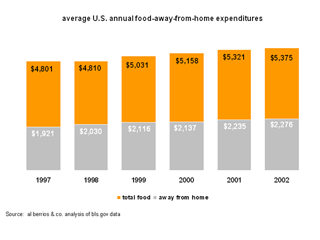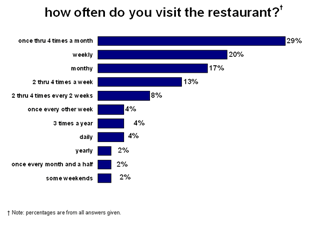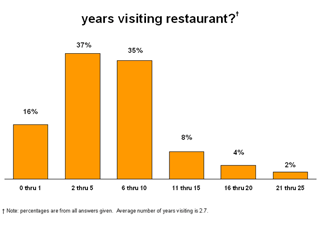consumer
To see me armed with goggles, gloves, and sanitary mask, you'd think I'm about to clean a public men's room. Instead, I'm about to clean out my fridge. The thought alone is enough to make me refer to my "cookbook" - the menu folder - for solutions, leaving already unrecognizable fruits and veggies to continue to de-evolve into goo.
 |
Although the average total food expenditure for someone like me is about 11%, almost 40% of that goes to eating out. (I'm probably at 90%, since I've just stopped buying groceries altogether). My mom, of course, laments this tragic waste of money and unhealthy diet, but I figure, I'm still at around 11% and frankly, I believe that by going to multiple restaurants to eat, I'm balancing out my health.
According to a study analyzing consumers' thoughts on dining out published this month by al berrios & co., turns out I'm not unique. In the last six years, food expenditures away from home have been growing faster than growth of total food budgets.
 |
In addition, we're all also balancing out eating-away-from-home diets as consumers are clearly less inclined to have every meal occasion at their favorite restaurants, preferring an average of a week to go between visits, regardless of convenient locations and relatively affordable prices, according to the study. More plainly, 44% of consumers are not concerned with how healthy their food is at their favorite restaurants.
Consumers' interest in exploring alternative restaurants may also be attributable to casual dining restaurants' increasing their awareness efforts, too - almost 55% of new restaurants discovered by our population was American casual vs. American fast food at 16%. (This same trend was also noted by industry analysts, who point out that casual dining has increased their "chain penetration levels" and improved their "brand development" [1].)
 |
This, along with the significant drop in visits after 10 years visiting their favorite restaurants, may also be evidence that America's reported fascination with a mobile meals doesn't appear to hold fast throughout all age brackets and meal occasions in the study; and that innovation was indeed stagnant for an entire generation of restaurant guests.
Despite our seemingly newfound awareness of so many restaurant alternatives, quick service restaurants have been marketing more efficiently than casual dining restaurants far longer. The study ranks consumers' preference of McDonalds, Burger King, and Wendy's as their top three favorite restaurants. In fact, McD's spends only 37% more than Burger King and Wendy's combined on marketing to be preferred by nearly twice as many people as both BK and Wendy's. And the most amazing thing, 92% of consumers agreed that the customer service is actually good, great, or excellent.
Based on this study, it's
only a matter of time before we run into each other at our favorite restaurants.
If so, don't be a stranger.
Write to
Al Berrios at editor@alberrios.com
Top
Footnotes
(1) "Restaurant Review", February 2004, Bear Stearns Equity Research
Top
Related al berrios & co.
articles
- "al berrios & co. August 2004 Study
on Consumers’ Thoughts on Dining Out"
- "What a Successful Casual Dining Restaurant
Looks Like"
Top
Related alberrios.com Sections
- Our latest thinking on the restaurant industry
- Our coverage of retail brands
- Our coverage of restaurant brands
- Our research
on the retail industry
- Our latest thinking on consumer perceptions
- Our analyses of the latest thinking in the
retail industry
- Learn
more about the retail + restaurant
industries
- Consumer
advocacy
- News about
the retail industry
Top
Disclaimer:
The recommendations, commentary and opinions published herein are based on
public information sometimes referenced via hyperlinks. Any similarities or
likeness to any ideas or commentary from any other sources not referenced
is purely coincidental. al berrios & co. cannot control any results occurring
from advice obtained from this publication nor any opinion(s) conveyed by
any reader of this publication.
al berrios & co. does and seeks to do business with companies covered
in its research reports and studies. As a result, the reader should be aware
that the firm may have a conflict of interest that could affect the objectivity
of this report or study. Readers should consider this report or study as only
a single factor in making any strategic or investment decisions.
(c) 2001-2005. All Rights Reserved. al berrios & company, inc. Published by al berrios & co. This Report may not be reproduced or redistributed in any form without written permission from al berrios & co., subject to penalty.